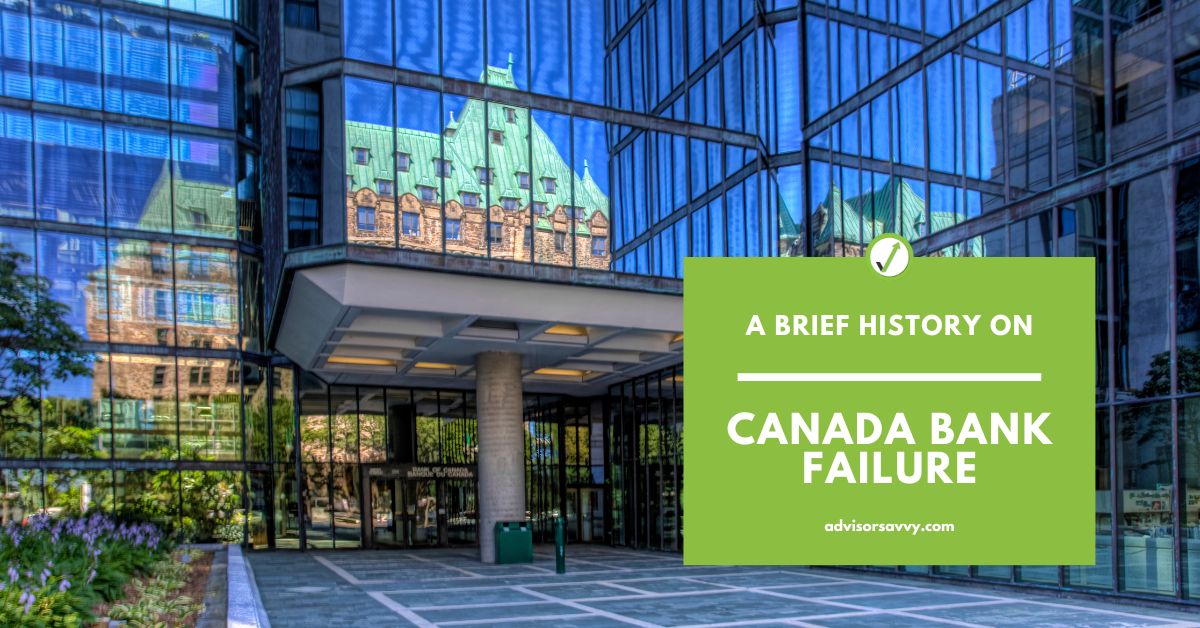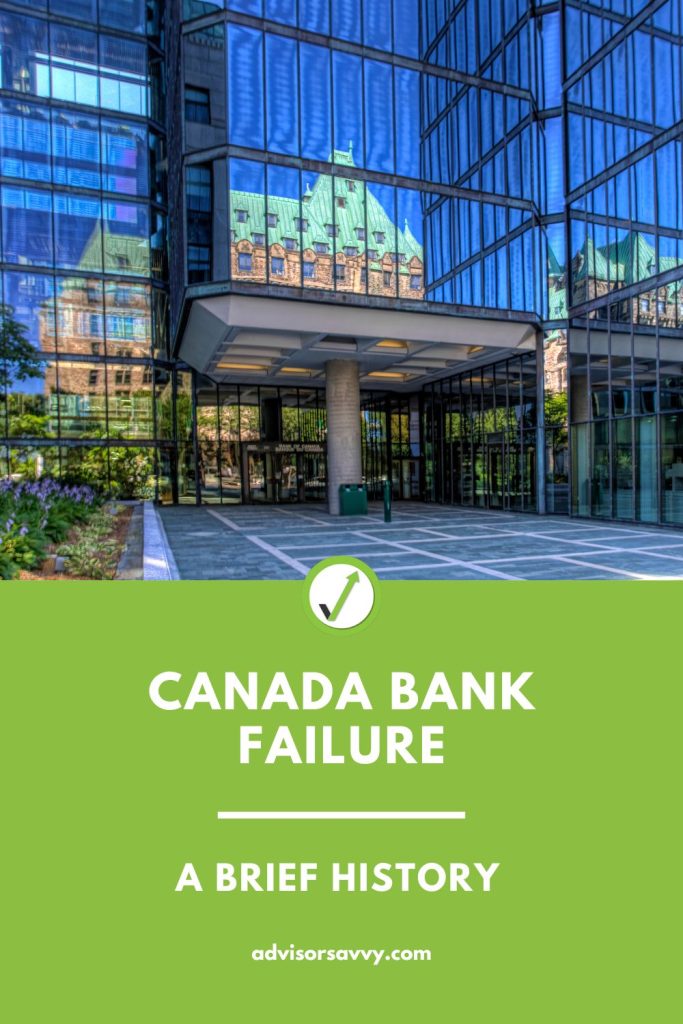
Canada has a historically strong banking system. From 2000 to present, there have been zero bank failures. In the United States of America, there have been over 500 bank failures since 2000. For this reason, many are curious about potential Canada bank failure given the tumultuousness of our southern neighbors.
The Bank of Canada started operations in 1935 and the Canada Deposit Insurance Corporation (CDIC) was founded in 1967. There have been significant protections put in place by these entities. This ensures economic stability within Canada’s financial sector. In addition, the regulation prevents Canada bank failure. The “Big Five” banks absorb or merge with failing smaller banks prior to their collapse in many instances. Canada has avoided many bank failures this way. Furthermore, Canada and its population tend to value larger, central, and more stable banks. In fact, they prefer it over smaller, regional financial services.

Table of contents
- How many banks in Canada have failed?
- When was the last Canadian bank failure?
- Are any Canadian banks at risk of failing?
- Which bank is too big to fail in Canada?
- What happens to my money if a bank closes?
- How to protect my investment account if bank failure in Canada happens?
- What is the safest bank in Canada?
For the few banks failures Canada has had, the CDIC has been able to step in and insure all balances. There are some historical bank failures of interest, which we’ll cover below. What is happening currently in the United States of America has set alarm bells off on a global stage. With the collapse of Silicon Valley Bank and Signature Bank in early 2023, the world is watching all banks. Keep reading to learn about bank failures in Canada.
CIBC Investor’s Line Offer
Up to $6.95 per online stock or ETF trade. Plus, there’s no minimum account balance.
How many banks in Canada have failed?
In 1867, Canada confederated into one country. From 1867 until 1923, Canada had a bank failure rate of 40%. This is a stark difference from the modern-day situation. With no financial failures in over twenty years, it is difficult to imagine a time in Canada when banks would fail at such alarming rates. The truth is, before confederation, banks were failing at even more alarming rates.
The last major bank failure in Canada to cause waves across the nation was in 1923, when the Home Bank of Canada failed. The bank could not keep up with new banking regulations. They had bad loans and were mismanaged.
Canadian government and populations then favored large, national, centralized, and heavily regulated banks. There was a brief period in the 1970s when smaller regional banks regained traction. In 1985, two Western Canadian based banks collapsed. Specifically, the Canadian Commercial Bank and The Northland Bank failed. Policies and consumers returned to favoring big banks to prevent Canada bank failure following this event.
Finally, the last noteworthy financial collapse was in 1996. Calgary-based Security Home Mortgage Corporation shut down in that year. Canadians lost access to $42 million dollars. Fortunately, the Canada Deposit Insurance Corporation (CDIC) stepped in. They returned consumers money within 3 weeks. Even though Canada bank failure is a scary thing, the CDIC has come through a few times to ensure Canadians get their money back!
Related Reading: Estate Planning Checklist for Canadians
CIBC Investor’s Line Offer
Up to $6.95 per online stock or ETF trade. Plus, there’s no minimum account balance.
List of Canada Bank Failures
The Canada Deposit Insurance Corporation (CDIC) has handled a total of 43 financial failures. Below is a list of all the failures, with the year of the failure and the name of the financial institution that failed. Not every one of these financial institutions is a bank. They could have been credit unions, trusts, or other smaller financial institutions. The list has been taken directly from the CDIC website.
- 1996 – Security Home Mortgage Corporation
- 1995 – NAL Mortgage Company
- 1995 – North American Trust Company
- 1995 – Income Trust Company
- 1994 – Monarch Trust Company
- 1994 – Confederation Trust Company
- 1993 – Prenor Trust Company of Canada
- 1993 – Dominion Trust Company
- 1992 – First City Mortgage Company
- 1992 – First City Trust Company
- 1992 – Central Guaranty Trust Company
- 1992 – Central Guaranty Mortgage Corporation
- 1992 – Shoppers Trust Company
- 1991 – Standard Trust Company
- 1991 – Standard Loan Company
- 1991 – Saskatchewan Trust Company
- 1991 – Bank of Credit and Commerce Canada
- 1990 – Settlers Savings and Mortgage Corporation
- 1988 – Financial Trust Company
- 1987 – Principal Savings & Trust Company
- 1987 – North West Trust Company
- 1986 – Columbia Trust Company
- 1986 – Bank of British Columbia Mortgage Corporation
- 1986 – Bank of British Columbia
- 1985 – Western Capital Trust Company
- 1985 – Pioneer Trust Company
- 1985 – Northland Bank
- 1985 – London Loan Limited
- 1985 – Continental Trust Company
- 1985 – Canadian Commercial Bank
- 1985 – CCB Mortgage Investment Corporation
- 1984 – Northguard Mortgage Corporation
- 1983 – Seaway Trust Company
- 1983 – Seaway Mortgage Corporation
- 1983 – Greymac Trust Company
- 1983 – Greymac Mortgage Corporation
- 1983 – Fidelity Trust Company
- 1983 – Crown Trust Company
- 1983 – AMIC Mortgage Investment Corporation
- 1982 – District Trust Company
- 1980 – Astra Trust Company
- 1972 – Security Trust Company Limited
- 1970 – Commonwealth Trust Company
When was the last Canadian bank failure?
The last major financial institution to fail was Security Home Mortgage Corporation in 1996. During this Canada bank failure, 2,600 were left without access to their money. The Canada Deposit Insurance Corporation (CDIC) stepped in and returned consumers money within 3 weeks.
In 1985, The Canadian Commercial Bank and The Northland Bank failed. This caused other smaller, western, regional banks and institutions to fail. In terms of Canada’s banking history, this collapse was likely the most notable. The common characteristic of most institutions that failed at this time was oil. The oil industry is infamous for it’s cyclical nature filled with highs and lows. Most of these banks were in western Canada and heavily invested in oil. When policy and demand shifted, they became insolvent. At the time, the Canadian Commercial Bank was the largest bank failure in Canada in 60 years.
Are any Canadian banks at risk of failing?
In general, Canada’s banking system is secure and stable, as you can see from history. A bank hasn’t collapsed in almost 30 years. However, some are skeptical because of recent bank failures in the United States and other parts of the world.
One of Canada’s “Big Five” Banks, TD Bank, is being watched closely by short traders and other high profile investors. TD stock experienced a short market position at the start of the second quarter of 2023. The short position is valued at approximately $6.1 billion. This could be considered alarming to some.
Most economic and financial sector gurus believe this was a result of TD Bank’s planned acquisition of U.S. lender, First Horizon. The short position came after the failing of Silicon Valley Bank and Signature Bank. There was a temporary anxiety for TD Bank and shareholders as they were in the midst of a major acquisition. The United States financial sector was experiencing their second and third largest bank collapses in history. This is likely to level out and not be of great concern to TD Bank and its operations in the long run.
CIBC Investor’s Line Offer
Up to $6.95 per online stock or ETF trade. Plus, there’s no minimum account balance.
Which bank is too big to fail in Canada?
Canada has its “Big Five” banks, sometimes expanded to the “Big Six.” These banks include:
- Bank of Montreal (BMO)
- Bank of Nova Scotia (Scotiabank)
- Canadian Imperial Bank of Commerce (CIBC)
- Royal Bank of Canada (RBC)
- Toronto-Dominion Bank (TD)
- National Bank of Canada-which (the country’s sixth largest bank)
These banks are national banks, with diverse portfolios. Combined, the six banks account for 90% of the market share in Canada. The “Big Five” are all in the top 100 largest banks in the world. These financial institutions cooperate well with each other, as well as being independent companies. There have been past attempts at mergers.
To prevent banking monopolies in the country, the government has prevented these mergers. Having six large and strong banks allows competition which is better for the consumer. These banks cooperate closely with each other. The chances of one of these banks failing is considered low. There is currently no foreseeable Canada bank failure. Particularly for these large institutions who are generally perceived as too influential to collapse. If there was, the government would likely step in and allow a merger to occur. There is further protection through the Canada Deposit Insurance Corporation (CDIC) for these banks, should they ever collapse.
Related Reading: Secured Credit Card Canada: A Complete Guide
What happens to my money if a bank closes?
If a bank were to close, Canada’s insuring body should be able to step in and back a certain amount of money. In other words, depositors will receive their money through CDIC insurance, given that the bank was insured. However, the government would likely take additional steps to prevent a collapse. It would be in the best interest of other big banks to try and intervene as well. Let’s take a closer look below.
Canada Deposit Insurance Corporation
The Canada Deposit Insurance Corporation (CDIC) insures member institution accounts. It is a federal crown corporation. Each client account is automatically insured for up to $100,000 CAD in case of Canada bank failure. There are additional measures that the CDIC can take to ensure bank failure does not occur.
The CDIC Insures:
- Banks
- Federally regulated credit unions
- Loans and trust companies
- Associations governed by the Cooperative Credit Associations Act that take deposits
Coverage exists for:
- Savings accounts
- Chequing accounts
- GICs and other eligible term deposits
- Mutual funds, stocks and bonds, foreign currency, cryptocurrencies are not covered by CDIC
Your bank must be a member of CDIC in order for you to receive reimbursement in the event of Canada bank failure. You may want to reconsider your financial institution if your current one doesn’t possess coverage.
How to protect my investment account if bank failure in Canada happens?
The Canadian Investor Protection Fund (CIPF) is a not-for-profit organization. It helps protect customers of investment and mutual fund dealers. If your investment account is a member through a Canadian Investment Regulatory Organizations (CIRO), you are protected. CIPF protects your property from a member investment firm going insolvent. Cash, securities, futures, and segregated insurance funds are all protected. Coverage amounts reach $1 million for accounts combined. However, there are 3 categories of accounts eligible for this $1 million coverage. You may want to diversify your portfolio into TFSAs, RESPs, RRSPs and more. If you are new to investing, you may want to learn using the Best Investing Books For Canadian Investors.
What is the safest bank in Canada?
Canada has had an extraordinarily strong banking industry. It has made it through all modern-day economic downturns safely. The “Big Six” banks all offer the same centralized, regulated, and diversified security. Depending on your needs and the branches closest to you, you may decide on a different bank than someone else. In Canada, you can feel safe choosing any of the large banks.
Read More: 8 Best Free Bank Accounts in Canada

